|
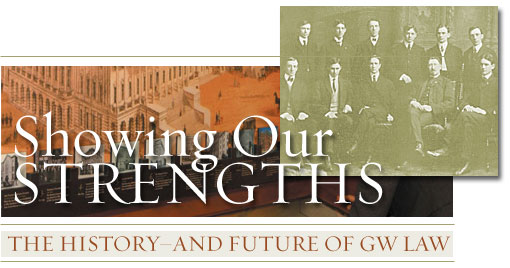
 |
|
GW President Stephen Joel Trachtenberg and Interim Dean Roger Trangsrud officially open the Law School history exhibit on Aug. 30.
|
Black-and-white photographs, sepia-tinted newsprint, and modern touch-screen technology are all fitting media to showcase GW Law’s history, as this year the University honors the school’s past and future with a new exhibit in Lerner Hall’s Kelly Lounge. On Aug. 30, Interim Dean Roger Trangsrud and GW President Stephen Joel Trachtenberg cut the ribbon on the exhibit, which is an interactive blend of archive documents, maps, and colorful photos paying tribute to the oldest law school in the District of Columbia. Four panels take the viewer through the founding of the Law School in the 1820s through the present day, revealing the efforts and accomplishments of alumni and faculty, University milestones, and the programs and technological advancements that have brought the Law School into the 21st century.
The Oldest Law School in D.C.
The oldest law school in the District of Columbia, GW Law has come a long way since its fledgling steps in the 1820s. The school shut down in 1826 due to lack of enrollment, and during the Civil War, the grounds were occupied by Union troops, with its main building used as a convalescent ward. The school was re-established in 1865 and has steadily grown since. GW Law also boasts the oldest intellectual property program in the country, and alumni have written patents for some of the greatest technological achievements of the past 130 years—including the Wright brothers’ flying machine, patented on May 22, 1906, through the efforts of Harry Aubrey Toulmin, who graduated from the National Law Center in 1882. Countless other GW graduates, faculty, and programs continue to make waves today, as technology, diversity, and lessons from its rich history advance the school into its third century.
|

Photo above by Claire Duggan
|
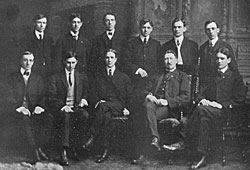
1903 class officers and executive committee
|
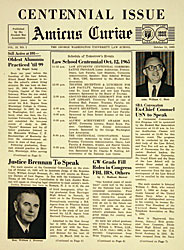 |
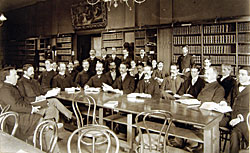
The student newspaper celebrates the Law School’s centennial in October 1965.
|
George Washington’s Legacy—The Law School in the Heart of the Nation’s Capital
In George Washington’s will, 50 shares of stock in Potowmack Canal Company were set aside to help carry out the president’s dream of establishing a national university. Since its first days in the 1800s, the University and the District of Columbia have had a unique partnership. GW Law has certainly benefited from its ties to D.C., and students have enjoyed a front-row seat to legal and historical milestones. In turn, the District has benefited from the efforts of GW students, faculty, and alumni. Many GW Law graduates went on to serve their states and their countries as civil servants, federal and state judges, Cabinet officials, and members of Congress. From J. Edgar Hoover to Georgian President Mikheil Saakashvili to former attorney general of Nevada Frankie Sue Del Papa, an interactive touch-screen portion of this section of the exhibit showcases alumni who have used knowledge gained at GW Law to serve the nation and the world.
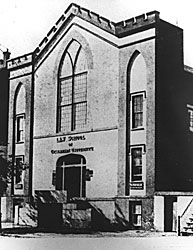
The Old Trinity Episcopal Church, located on Fifth Street between D and G Streets in Washington was used by the Law School from 1865 to 1884.
|
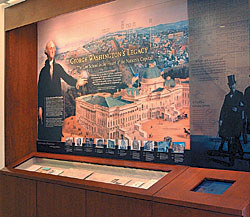
Photo above by Claire Duggan
|
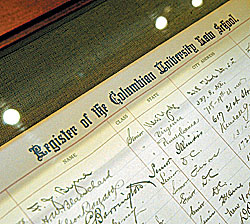
Register of Students, 1888
Photo above by Claire Duggan
|
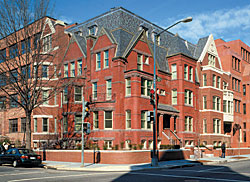
Today, the Law School occupies an entire city block.
Photo above by Bob Narod
|
Practicing Advocacy—Honing Courtroom Skills at GW Law
For more than a century, GW Law students have sharpened their preparation and performance skills through oral advocacy clubs and competitions. In 1903, the Debating Society was the only extracurricular club supported by the Law School. “Case clubs” formed in the middle of the century to familiarize students with the preparation and presentation of legal arguments. One of these organizations, the Van Vleck Case Club, sponsored the first moot court competitions recognized by the University. Today, the student-run Moot Court Board, Mock Trial Board, and Alternative Dispute Resolution Board carry on the tradition of excellence in oral advocacy by hosting, participating in, and winning, in-house, regional, and national competitions.
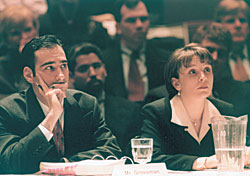 |
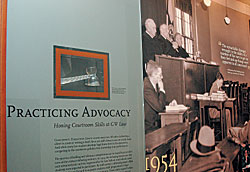
Photo above by Claire Duggan |
|
A 1963 issue of the Amicus Curiae features photos of Supreme Court Justices Tom C. Clark and Byron R. White as well as Judge Walter M. Bastion of the D.C. Court of Appeals. The men judged that year’s Van Vleck Case Club Argument finals held at the Law School.
|
Oral advocacy clubs at GW Law often partner students with mentors—faculty members and professional alumni—to polish their skills.
|
The Changing Face of GW Law
“Here was to be found the genial companionship of books and men,” states a 1903 Columbian. In keeping with the evolution of the Law School’s physical presence and classes and programs, the student body itself also has changed over the years. Diversity of gender, race, and culture has led to a wealth of different outlooks, ideas, talents, and social concerns within the Law School community. Now can be found the “genial companionship” of men and women from all over the world—a rich community of faculty, students, and visiting scholars.
|
A 1961 issue of the Amicus Curiae advertises a meeting of the Students’ Wives Club.
|
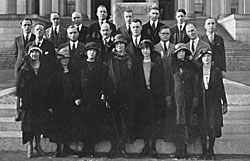
Members of the National Law Center Class of 1924 visit the Supreme Court. GW and National merged in 1954.
|
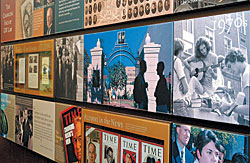
Photo above by Claire Duggan |
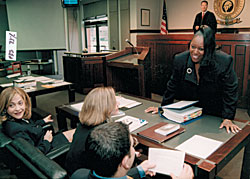
Associate Dean for Strategic Planning and Skills Training Alfreda Robinson consults with students.
|
Back to top | Fall 2004 Table of Contents
|